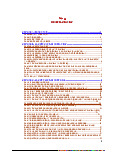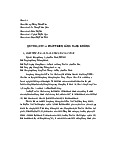



















Preview text:
CASE STUDY: Malaysia Airlines Flight MH17
(Bản tin truyền hình tổng kết vụ tai nạn của kênh AC Channel (Airplane Crash), MC, biên tập viên)
Intro: On 17 July 2014, 298 people lost their lives when the Malaysia Airlines airplane they
were in crashed near Hrabove, a village in the eastern part of Ukraine. The crash of flight
MH17 caused the relatives of the occupants profound grief. There was also considerable
dismay all over the world, especially when it became apparent that the airplane had
presumably been shot down. The questions evoked by the crash were penetrating: Was the
airplane actually shot out of the sky? If so, why was the airplane flying over an area where
there was an on-going armed conflict? And who is to blame for the crash. 1. Overview 1.1. About Malaysia Airlines
Malaysia Airlines was founded in Singapore on 12 October, 1937 as Malayan
Airways Limited. The first commercial flight was only boarded in 1947, some 10
years later. When the Federation of Malaysia was established in 1963, the airline’s
name changed to Malaysian Airways. Then, following Singapore’s separation from
Malaysia in 1965, the airline’s name was changed again to Malaysia-Singapore
Airlines before the airline ceased operations after six years in 1972 when both
Malaysia and Singapore decided to establish their own flag carriers – Malaysian
Airline System (MAS) and Singapore Airlines.
It was based in Kuala Lumpur international Airport with hubs at Kota Kinabalu
international Airport, Kuching International Airport, Penang International Airport.
In 2014, less than five months apart, Malaysia Airlines lost two aircraft under
unusual circumstances – Flight 370 that disappeared while flying from Kuala Lumpur
to Beijing and Flight 17 from Amsterdam to Kuala Lumpur that was shot down while
flying over eastern Ukraine. Prior to 2014, the airline had one of the world’s best
safety records – just two fatal accidents in 68 years of operation.
On September 1st, 2015, Malaysian Airline System Berhad (MAS) relaunched
as Malaysia Airlines Berhad (MAB), with the rebranding of the airline also commencing that day. 1.2. Aircraft information - Manufacturer: Boeing - Type: 777-200ER - Serial number: 28411 - Registration: 9M-MRD
- Entry into service 17/07/1997
- Airworthiness certificate: The Department of Civil Aviation Malaysia issued a
certificate of airworthiness numbered M.0817 on 07/07/2014
- Airworthiness Review:08/07/2013 valid until 29/07/2015 - The scheduled maintenance
- Utilization as: The airplane had accumulated 76,322 flight hours and 11,434 cycles
- Engines Type: tow rolls-royce Trent - 892B series engines. - The airplane was destroyed. 1.3. Personnel information
According to the documents and information received from Malaysia Airlines
the flight crew was properly licensed to conduct the flight. The flight crew consisted
of two Captains, two First Officers (all of whom were fully qualified to operate a
Boeing 777-200) and eleven cabin crew members. Team A Nguồn: Team B Nguồn:
The operator’s Operations Manual Part A sets out procedures to meet the
applicable flight time limitations regulations. For a flight of around 12 hours, four
pilots, two of whom are Captains, are required. On flight MH17, two captains and two
First Officers were scheduled to operate the flight in two teams; Team A and Team B.
Team A flew the first part of the flight and were at the controls at the time of the crash,
the Captain in the left pilot seat and the First Officer in the right pilot seat. When not
acting as pilots, it is common practice for the other flight crew members (Team B, in
this case) to rest in the bunks that are located behind the cockpit, in a seat in business
class or to occupy the observer seats in the cockpit. 1.4. Damage 1.4.1. Injuries to persons
During its final flight, the aircraft was carrying 283 passengers (Includes three
infants less than 2 years old and many other children.) and 15 crew died (four pilots
and 11 cabin crew members) from at least 10 countries - mostly the Netherlands.
The occupants of the airplane were citizens of the following states: Netherlands 193 Malaysia 43 Australia 27 Indonesia 12 United Kingdom 10 Germany 4 Belgium 4 Canada 1 New Zealand 1 Total 298 Nguồn:
No reports were received regarding injuries or fatalities to persons on the
ground as a result of the crash. Hình ảnh : 1.4.2. Damage to the aircraft The airplane was destroyed.
Nguồn: Báo người lao động. 1.4.3. Other damage
Damage was caused to houses, buildings, parts of the infrastructure and agricultural
ground as a result of a combination of the airplane wreckage, human remains, cargo
and baggage falling on the ground and the post-crash fire. This information was
obtained via photos taken by the investigators and police, as well as media
information and material published on the internet. 2. Accident happenings
On 17 July 2014, the subject airplane, a Malaysia Airlines Boeing 777-200 with
nationality and registration marks 9M-MRD, had arrived at its gate at Amsterdam
Airport Schiphol in the Netherlands at 04.36 (06.36 CET) from Kuala Lumpur
International Airport in Malaysia.
At 10.13 (12.13 CET), after having been serviced and prepared for flight, the
airplane left gate G3, thirteen minutes later than planned, primarily due to
overbooking and the late arrival of some transfer passengers, on a scheduled
passenger flight to Kuala Lumpur with flight number MH17.
Malaysia Airlines had prepared and filed an air traffic control flight plan. The
flight crew was provided by the ground handling agent with an operational flight plan,
NOTAMs,4 load information and weather information prior to departure. The material
had been prepared in Kuala Lumpur by Malaysia Airlines. The operational flight plan
contained detailed route information, a summary of the mass data, fuel information
and information on the winds and temperatures along the route.
There were 298 persons, including 283 passengers on board the airplane. The
crew was composed of four flight crew members and 11 cabin crew members.
MH17's routes will fly through German and Polish airspace. then will fly
through Ukrainian airspace where there is fierce fighting between the pro-Russian
separatist faction and Ukraine.
Diagram of the route planned. (Source: Google, INEGI)
15:53 minutes after nearly four hours of takeoff, MH17 entered Ukrainian
airspace. The plane was 33,000 feet high. Air traffic station Asked if MH 17 can climb
35,000 feet as planned? Because another Singapore Airline flight was also flying at
33,000 feet at this time. The crew then replied that they did not want to climb 35,000
feet as planned. Air traffic station approved MH17's request and Singapore Airlines'
request for a Singapore Airline flight climbed to 35,000 feet instead. Parties communicating
Nguồn: Extract from Air Traffic Control (ATC) transcript
At 16:00 local time, crew requested the aircraft to fly 20 nautical miles north
due to bad weather conditions. The request has been approved by the ATC. The Crew
then asked ATC if we could climb 34,000 feet? But the ATC turned it down because
that altitude was not yet used.
Figure 3: Route of flight MH17 across the eastern part of Ukraine. The light grey
shading shows the area that is 5 NM left and right of the centreline of airway L980.
The black line shows flight MH17 deviating from airway L980 between air navigation
waypoints PEKIT and TAGAN. (Source: Google, Landstat)
16:19 minutes ATC detected MH 17 flying 3.6 nautical miles north from the
main route and asked to return to the flight route. A few minutes later ATC contacted
the Russian Air Traffic Control Station requesting clearance because flight MH 17 was
about to enter Russian airspace. After being approved, ATC contacted MH17 to report
the situation, but received no response from MH 17.
The plane was shot down by surface-to-air missiles and impacted the ground
near the village of Hrabove in the eastern part of Ukraine. The moment of impact
could not be determined exactly. However, in various articles and videos from the
media, local habitants described parts of the airplane falling from the sky and some
wreckage and human remains impacted houses and gardens at about 16.30 local time
(15.30 CET). Wreckage parts of the airplane were spread over a number of sites, also
near the villages of Rozsypne and Petropavlivka.
Wreckage was identified within six different sites spread over an area of about
50 km2. The majority of the wreckage was located in three sites southwest of
Hrabove. The Boeing 777 crashed, killing all 283 people and 15 crew members.
Intro: Following the crash of Malaysia Airlines flight MH17 near the village of
Hrabove (in the eastern part of Ukraine), the Ukrainian authorities initiated an
investigation into the accident, in accordance with ICAO Annex 13. During the first
days of the investigation, the Ukrainian authorities requested the Netherlands, the state
with the largest number of nationals on board the airplane, to take over the
investigation. The Netherlands granted the request made by the Ukrainian authorities.
On 23 July 2014, Ukraine delegated the investigation to the Netherlands. Following
the provisions of ICAO Annex 13, from that date the Netherlands was the State
conducting the investigation. As the accident investigation authority of the
Netherlands, the Dutch Safety Board was tasked to conduct the investigation. 3. Causes of the crash (Xem thêm trang 253/279)
- Excluding other causes of the crash:
The cockpit voice recorder, the flight data recorder and data from air traffic
control all suggest that flight MH17 proceeded as normal until 13:20:03 (UTC), after
which it ended abruptly. A full listening of the communications among the crew
members in the cockpit recorded on the cockpit voice recorder revealed no signs of
any technical faults or an emergency situation. Neither were any warning tones heard
in the cockpit that might have pointed to technical problems. The flight data recorder
registered no aircraft system warnings, and aircraft engine parameters were consistent
with normal operation during the flight. The radio communications with Ukrainian air
traffic control confirm that no emergency call was made by the cockpit crew.
- Other findings related to the crash:
The available images show that the pieces of wreckage were pierced in
numerous places. The pattern of damage to the aircraft fuselage and the cockpit is
consistent with that which may be expected from a large number of high-energy
objects that penetrated the aircraft from outside. It’s likely that this damage resulted in
a loss of structural integrity of the aircraft, leading to an in-flight break up. This also
explains the abrupt end to the data registration on the recorders, the simultaneous loss
of contact with air traffic control and the aircraft's disappearance from radar.
If the cause of the downed flight MH17 is determined to be due to a technical
problem, it is calculated that when it hits the ground, large pieces of the wreckage will
still be intact. However, in this case, at the scene, people found the plane wreck with
thousands of small pieces of debris, stretching over the surface more than 16km.
Accordingly, another cause is believed to be the shoulder-fired missile of the
killer that shot down MH17. However, a man-portable missile with an average range
of only 4km at an altitude of nearly 4km cannot reach the 10km range of MH17.
Meanwhile, a missile company said that Malaysia Airlines flight MH17 was
shot down by a BUK missile system. The BUK air defense missile system has a range
of up to 24km, so it is fully capable of this. Most recently, the Russian Investigative
Committee (IC) concluded that flight MH17 may have been shot down by a surface to air missile.
Generic form of a surface-to-air missile. (Source: Dutch Safety Board)
- Supporting conclusions (causes of the crash):
The researchers analyzed recorded data and debris and partly reconstructed the
fuselage skin of the aircraft. After ruling out bad weather, pilot error, mechanical
failure, or onboard fire or explosion, they concluded that the crash was caused by the
detonation of a warhead from a radar-guided missile fired from a Buk (also called SA-
11) surface-to-air system that was more than capable of reaching the cruising altitude
of flight 17. The missile never struck the aircraft directly. Instead, as intended, its
warhead exploded a few feet away from the cockpit, propelling hundreds of shrapnel
fragments through the fuselage. The cabin crew was killed instantly, and the forward
section of the aircraft broke off. The wings, passenger compartment, and tail remained
in the air at least a minute longer before separating and dropping to the ground.
In September 2016 a Dutch-led prosecutorial team presented evidence that the
fatal missile was launched from separatist-held territory in Ukraine using weaponry
brought in from Russia and returned to that country on the same day.
On June 19, 2019, Dutch prosecutors filed charges against four men - three
Russians and a Ukrainian - in connection with the downing of flight 17. All four were
associated with the Russian-backed military operation in eastern Ukraine, and the
three Russians had ties to Russian intelligence agencies. The most prominent suspect
was Igor Girkin, whom prosecutors identified as a former colonel with the Russian
Federal Security Service (FSB). Girkin, who used the nom de guerre Strelkov, was
commanding the Russian-backed forces in Donetsk, but he abruptly returned to Russia
within a month of the crash of flight 17. The Dutch investigation team also stated
conclusively that it possessed “evidence showing that Russia provided the missile
launcher” that shot down the airliner. Link hình Link hình
Dutch journalists in The Hague, in the corridor of parliament, the chairman of
the safety board, Tjibbe Joustra, later admitted that the Buk missile was fired from a rebel-controlled area.
The report by the Dutch safety board said that more than 120 objects, “mostly
metal fragments”, were found in the body of the first officer, who had sustained
“multiple fractures”. Dutch experts performed an “external and internal examination
on the captain’s body” and removed “hundreds of metal fragments”. They also
observed bone fractures and other injuries.
Among the fragments of missile shrapnel examined, two were in the shape of a
bow tie, which the Dutch board found to be characteristic of a particular type of Buk missile warhead.
A typical Buk surface-to-air missile system. (Source: Dutch Safety Board)
The Dutch Safety Board concluded that, on the basis of the combination of
findings of the recorded sound, the damage pattern found on the wreckage caused by
blast and the impact of fragments, the bow-tie shaped fragments found in the cockpit
and in the body of one of the crew members in the cockpit, the injuries sustained by
three crew members in the cockpit, the analysis of the in-flight break-up, the analysis
of the explosive residues and paint and the size and distinct, bow-tie, shape of some of
the fragments, the airplane was struck by a 9N314M warhead as carried on a 9M38-
series missile and launched by a Buk surface-to-air missile system.
(Thiệt hại nặng nề -> Trách nhiệm về ai? Bồi thường như thế nào?) 4.
Compensation (Chưa sửa xong) 4.1. Montreal Convention
Liability for the death of passengers on board an international flight is
determined by reference to international aviation treaties. The 1929 Warsaw
Convention was the first of these treaties. The most recent is the 1999 Montreal Convention.
The Montreal Convention entered into force on 4 November 2003. The
decision has applied since 5 April 2001. It was designed to replace the Warsaw
Convention system that had developed haphazardly since 1929 with a single, modern
and universal liability regime.
The treaty or treaties that apply to passengers on MH17 is determined by
finding the same treaty in place at the point of departure and the passenger’s final
destination. For MH17 that will generally be the Montreal Convention.
Under Article 21 of the Montreal Convention, for damages arising under
Article 17 not exceeding 113,100 SDRs (or about USD$173,000) per passenger, the
carrier cannot exclude or limit its liability. 4.2. Aviation insurance
MH17 passengers may also be subject to different liability regimes. MH17
crashed while flying from Amsterdam to Kuala Lumpur. The Montreal Convention
would apply to passengers on that ticketed one-way or return flight; both Malaysia
and the Netherlands are parties to that convention.
However, while 236 of the 283 passengers on board MH17 were of either
Dutch or Malaysian nationality, the remaining 47 passengers (including 27 of
Australian nationality) were made up of nationalities from eight other nations.
For many passengers on MH17, and regardless of residence, their journey –
their “ticketed” journey – may have been more extensive than the Amsterdam-Kuala
Lumpur flight and other, less favorable liability regimes may apply. To determine
liability, one looks for the same treaty in place at the beginning and end of a passenger’s total journey.
Airline insurers are reviewing cover for aircraft involved in hostile acts such as
the downing of Malaysia Airlines flight MH17 as the industry faces its most expensive
year since the 9/11 attacks in 2001.
Early indications suggest that Etiqa Insurance, a Malaysian based insurer,
underwrote 100% of the risk on the hull and liability cover. The majority of this was
then ceded to Allianz SE , through its speciality lines subsidiary, Allianz Global
Corporate & Specialty (AGCS), as the lead reinsurer on aviation hull and liability risks for Malaysian Airlines.
According to Aon, a broker specializing in monitoring the aviation insurance
market, the plane encountered an accident. The accident was worth about 97.3 million
USD. Allianz and its co-insurers will have to foot the bill for the cost of the missing
aircraft, as well as for payments due to the relatives of passengers aboard the flight.
Luckily, it seems that Malaysia Airlines also took out additional insurance
coverage in case the wartime exclusion clause would ever kick in. Therefore if the
clause does apply, then the cost of the plane, valued by Aon at US$97.3m, will fall to
the niche aviation war market. In a statement released on July 21 2014, Atrium
Underwriting Group Chief Executive Richard Harris[v] confirmed Atrium as the




